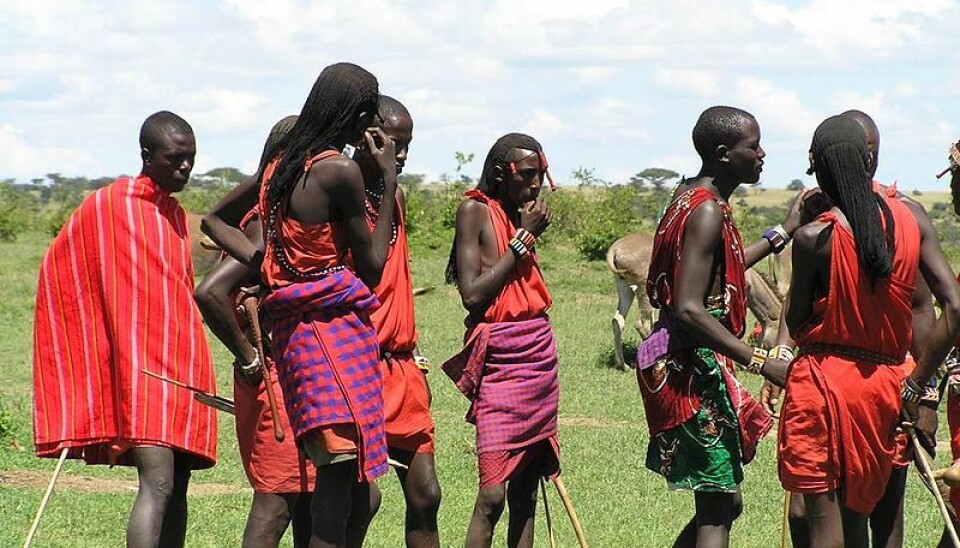
The Maasai keep healthy despite a high-fat diet
The Maasai in East Africa consume a high-fat diet, but they don’t seem to suffer from lifestyle diseases. Scientists have now discovered that the Maasai move with a surprisingly low intensity.
The Maasai are a very special people who live primarily from farming and livestock activities in Kenya and Tanzania. They have mystified researchers for years.
To a large extent, the Maasai live on the milk from their cattle, which means their diet is as full of fats as the diet of people living in the West. Unlike Westerners, however, the Maasai do not have many problems related to lifestyle diseases.
Health researchers around the world have therefore been greatly interested in these East Africans since cardio-vascular and other lifestyle diseases started to become a great problem in the west in the 1960s and 1970s.
To date, scientists have only studied the Maasai’s physical activities using questionnaires.
Perhaps genetic development means they have the ability to tolerate large quantities of saturated fatty acids.
But now Danish researchers are the first to have taken objective measurements of the level of physical activities of the Maasai.
The Maasai don’t run much
Surprisingly, the measurements show that the good health of the Maasai is not due to intense physical activity all day long. It seems that moderate but constant physical activity eplains the health difference between them and Westerners.
“The Maasai walk a great deal,” says Dirk Lund Christensen, an associate professor at the University of Copenhagen’s Department of International Health, Immunology and Microbiology, and the lead author of the study.
“Earlier studies from the 1960s and 1970s concluded that the Maasai were 'very active', in the way it was interpreted, they generated the false consumption that the Maasai displayed an athlete level of physical activity. From our objective measurements we can now see that their daily physical activity does not equal that of athletes. Most of their everyday physical activity is in the form of walking; very little time is spent running, which may not correspond to most people’s image of the Maasai.”
Measurements are much more reliable and credible than questionnaires, as there is a risk that people exaggerate or understate the true situation when answering questions about physical activity – especially men tend to exaggerate their physical activity level.
The Maasai move much more than we do
The researchers asked 370 Maasai to carry a little sensor that measured the pulse and body movements of the wearer.
The device, developed at Cambridge University, has the advantage that it weighs only eight grams, thus remaining without effect on the level of physical activity.
The Maasai taking part in the study were sent home with the device in place and were asked to live as normal for five days.
Using the device, the scientists registered the wearers’ activity in kilojoules per kilo of body weight per day (kJ/kg/d).
“On average, the Maasai move 75 percent more than we do in the West,” says Christensen. “Our activity level is about 44 kJ/kg/d, while for Maasai women the figure is 75 kJ/kg/d and for Maasai men it is 78 kJ/kg/d.”
The measurements also showed that while the Maasai move considerably, the intensity of their movements is low. This was furthermore supported by another measurement in which the scientists assessed the Maasai’s maximum oxygen intake (cardio-respiratory fitness or VO2 max) by using a step test. This way, they registered moderate VO2 max figures on average.
Fat Maasai are also healthy
The result is interesting, as the constant walking activity of the Maasai can contribute to their healthy condition despite their high-fat diet, says Christensen.
Through their clinical and biochemical measurements of the Maasai, the researchers found that:
- 8.7 percent of the study’s Maasai over the age of 18 years had high blood pressure. Africans are generally predisposed to high blood pressure, and town- or city-dwellers are most affected, with as many as 20 percent of them having high blood pressure, according to Christensen.
- High cholesterol values were found in 3 percent of the studied Maasai over the age of 18, which Christensen says is a low figure when their high-fat diet is taken into consideration.
- A study of overweight Maasai (with a BMI over 25) showed that they had a normal, healthy level of insulin. Few overweight Maasai showed signs of having moved into the pre-diabetes stage.
Some of the Maasai have too much abdominal fat. Ultrasound scanning showed that the Maasai have a great amount of fat around their inner organs. Usually an important marker of cardio-vascular diseases, this normally unhealthy fat distribution seems to have no real negative impact for the Maasai.
Genetic development may protect the Maasai
However, it is far from certain that an active life of herding cattle can explain why the Maasai are not subjected to lifestyle diseases.
“There may be something else giving them protection,” says Christensen. “Perhaps genetic development means that they have the ability to tolerate large quantities of saturated fatty acids. The explanation may also be that we have yet to see the consequences of a change in lifestyle among the Maasai in recent years, perhaps leading to increasing degrees of overweight in the population, and the development of cardio-vascular disease on average 10-15 years later.”
Until now, the Maasai’s diet has primarily been based on milk from their cattle.
Nevertheless as the Maasai have grown in number, and can no longer produce enough food for their own consumption in their traditional ways, they have been forced to include more and more foods from other sources in their diet, such as corn and millet. This means the Maasai’s diet is now far richer in carbohydrates than before.
Seasons important for the Maasai’s lifestyle
In addition, the study itself has limitations.
“Perhaps the Maasai’s physical activity and diet would have been different had we visited them at a different time of year,” says Christensen. “They have dry and wet seasons. Their cows produce less milk in the dry season, so the Maasai consume less milk during this period. With more visits we could have taken seasonal variations into account.”
Throughout the year the Maasai also have a number of ritual celebrations as part of which they engage in high intensity jumping during dancing. They also consume a lot of meat at these celebrations, although meat does not traditionally dominate their diet. However, there were no Maasai celebrations while the scientists were in Kenya for their study.
Christensen wants to return to Kenya with his colleagues to study the Maasai’s physical activity and diet habits during all four seasons to define a more complete and nuanced picture of the Maasai’s lifestyle.
-------------------------------------
Read the Danish version of this article at videnskab.dk
Translated by: Michael de Laine










